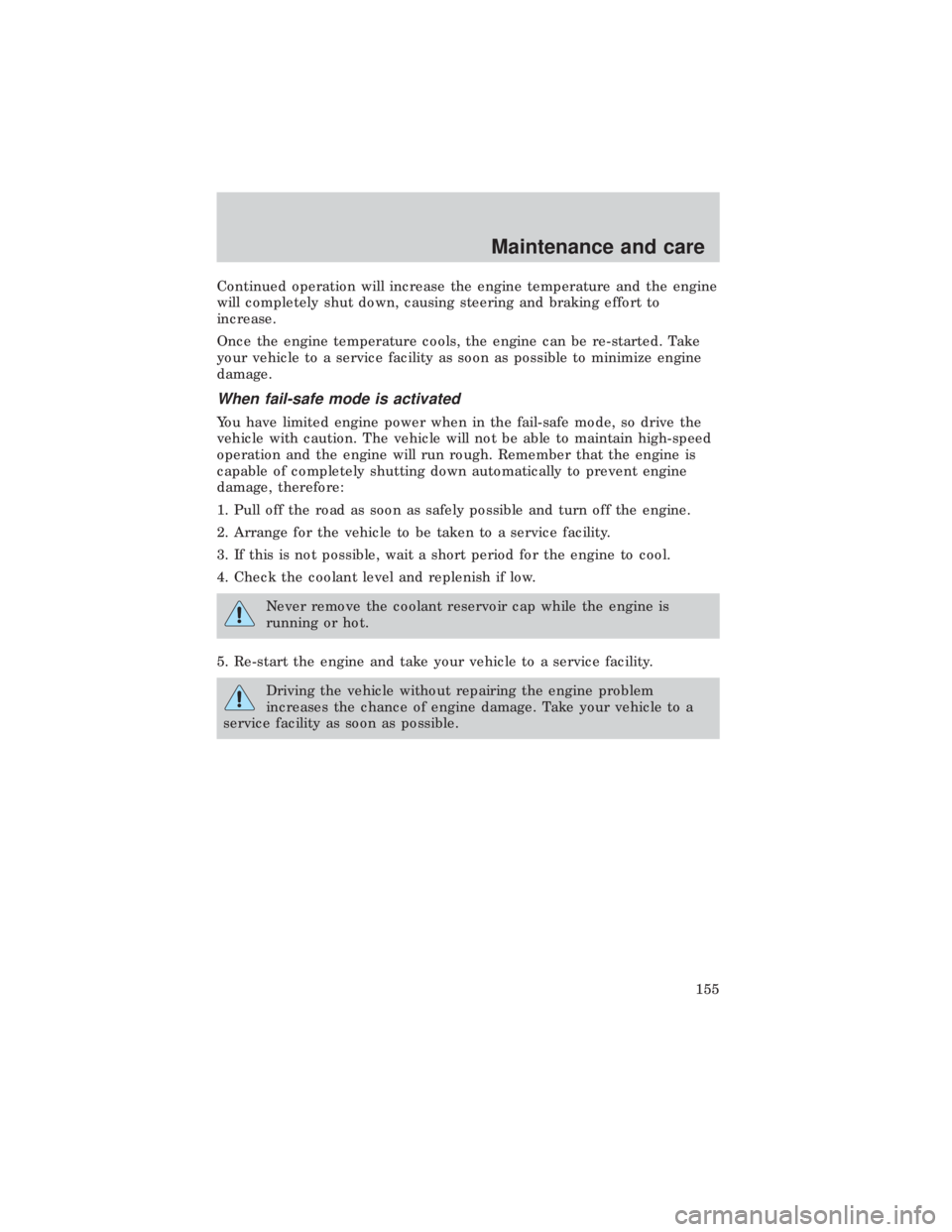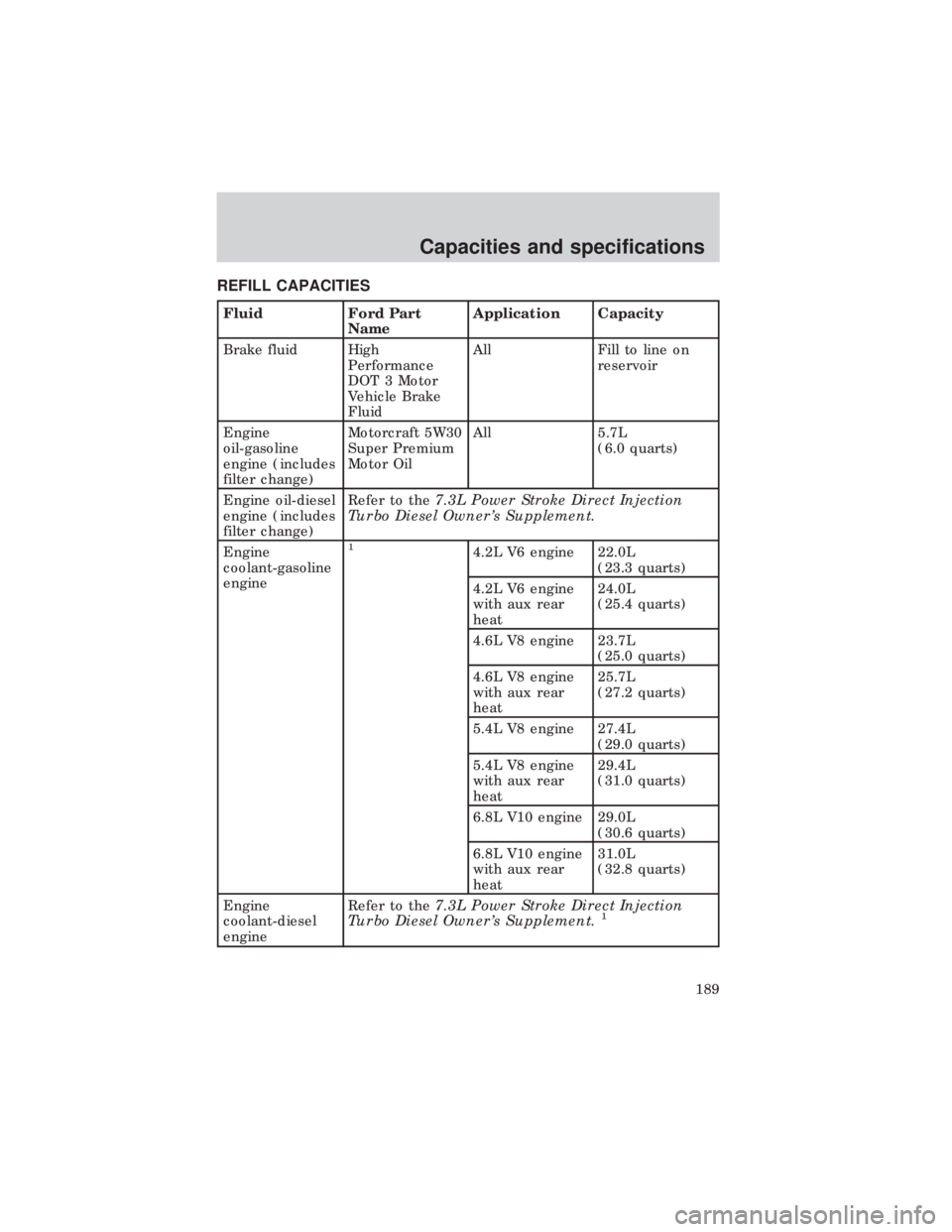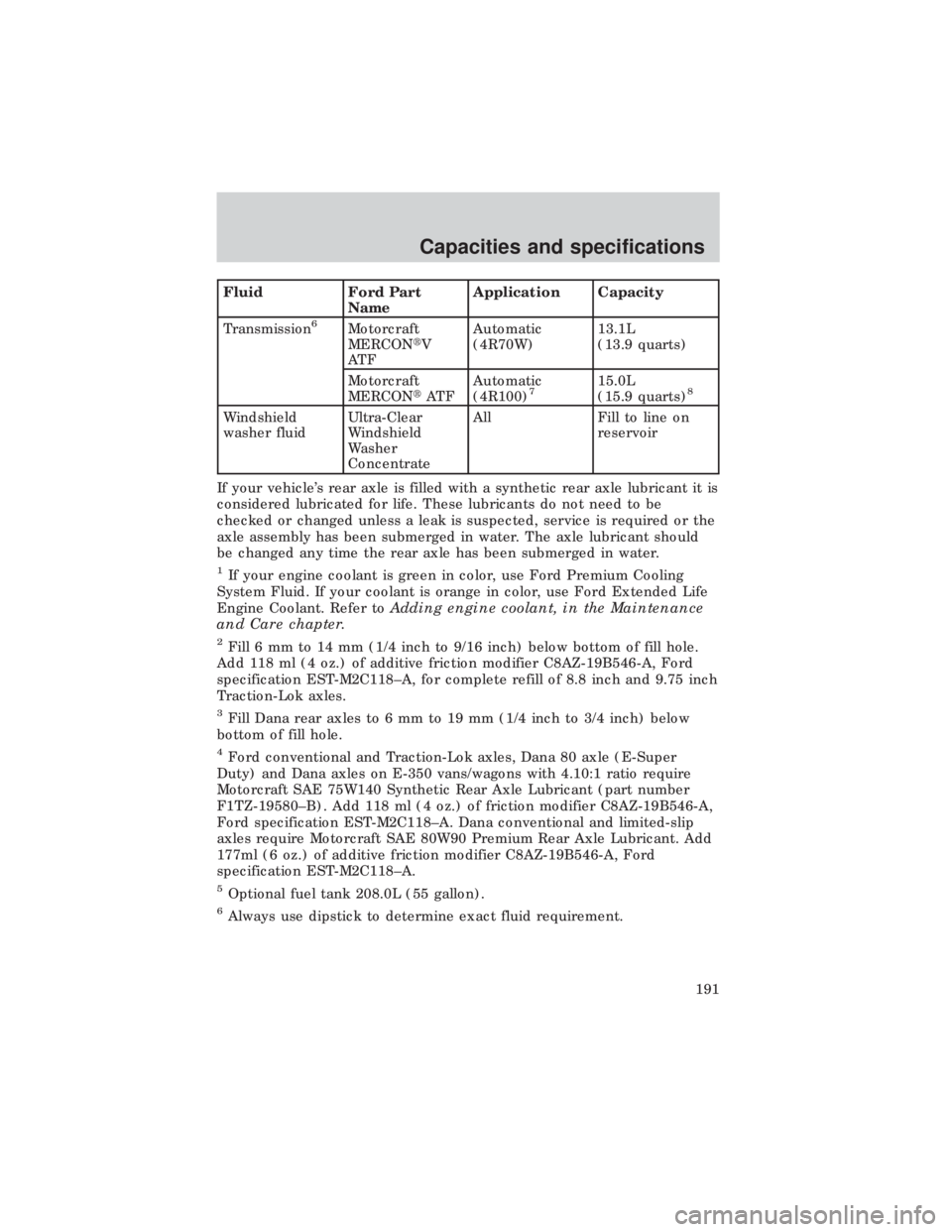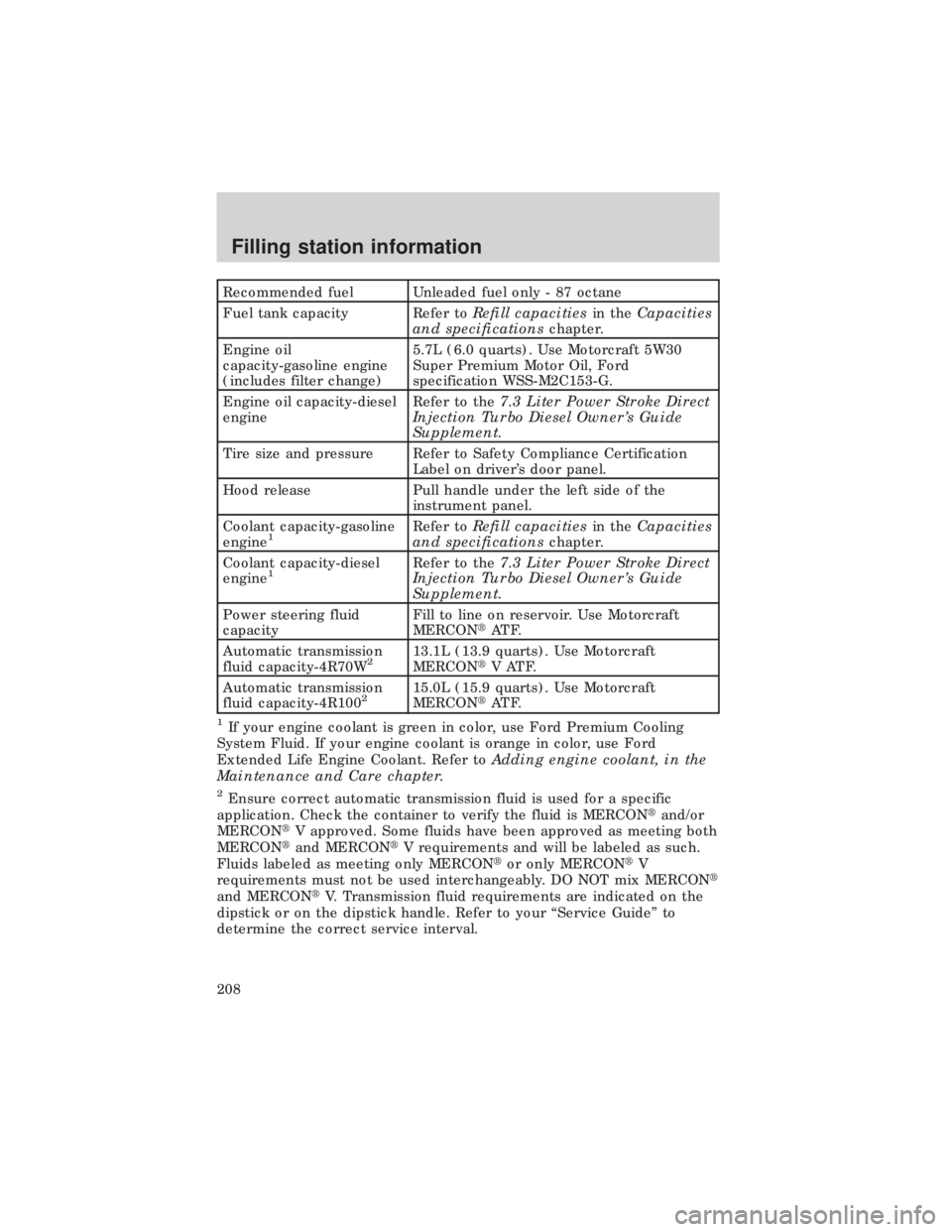1999 FORD E150 coolant reservoir
[x] Cancel search: coolant reservoirPage 13 of 208

Engine coolant temperature gauge
Indicates the temperature of the
engine coolant. At normal operating
temperature, the needle remains
within the normal area (the area
between the ªHº and ªCº). If it
enters the red section, the engine is
overheating. Stop the vehicle as
soon as safely possible, switch off
the engine immediately and let the
engine cool. Refer toEngine coolantin theMaintenance and care
chapter.
Never remove the coolant reservoir cap while the engine is
running or hot.
This gauge indicates the temperature of the engine coolant, not the
coolant level. If the coolant is not at its proper level the gauge indication
will not be accurate. If the gauge enters the red section, the oil
pressure/engine coolant andCheck Engine/Service Engine Soon
indicators illuminate, refer toWhat you should know about fail-safe
coolingin theMaintenance and care chapter.
Engine oil pressure gauge
This shows the engine oil pressure
in the system. Sufficient pressure
exists as long as the needle remains
in the normal range (the area
between the ªLº and ªHº).
If the gauge indicates low pressure,
stop the vehicle as soon as safely
possible and switch off the engine
immediately. Check the oil level. Add oil if needed (refer toEngine oil
in theMaintenance and carechapter). If the oil level is correct, have
your vehicle checked at your dealership or by a qualified technician.
H
C
H
L
Instrumentation
13
Page 147 of 208

IDENTIFYING COMPONENTS IN THE ENGINE COMPARTMENT
Engine compartment component locations
1. Windshield washer fluid reservoir
2. Engine oil filler cap
3. Automatic transmission fluid dipstick
4. Air filter assembly
5. Engine oil dipstick
6. Power steering fluid reservoir
7. Brake fluid reservoir
8. Engine coolant reservoir
9. Battery
ENGINE OIL
Checking the engine oil
Refer to the maintenance guide and or service guide for the appropriate
intervals for checking the engine oil.
1. Make sure the vehicle is on level ground.
2. Turn the engine off and wait a few minutes for the oil to drain into the
oil pan.
91234
5
6
7
8
Maintenance and care
147
Page 151 of 208

WINDSHIELD WASHER FLUID
Checking and adding washer fluid
Check the washer fluid whenever
you stop for fuel. The reservoir is
highlighted with a
symbol.
If the level is low, add enough fluid
to fill the reservoir. In very cold
weather, do not fill the reservoir all
the way.
Do not put engine coolant in the container for the windshield
washer fluid.
ENGINE COOLANT
Check the level of the engine
coolant in the reservoir. Refer to the
maintenance guide and or service
guide for service interval schedules.
Be sure to read and understand
Precautions when servicing your
vehiclein this chapter.
COLD FILL LEVEL
Maintenance and care
151
Page 152 of 208

If the engine coolant has not been checked at the recommended interval,
the engine coolant reservoir may become empty. If this occurs, add
engine coolant to the reservoir. For more information on engine coolant
maintenance, refer toAdding engine coolantin this chapter.
Automotive fluids are not interchangeable; do not use engine coolant,
antifreeze or windshield washer fluid outside of its specified function and
vehicle location.
Adding engine coolant
Do not put engine coolant in the container for the windshield
washer fluid.
Do not mix conventional green coolant, orange coolant or
recycled coolants together in your vehicle. Use only the type of
coolant that your vehicle was originally equipped with. If you are
unsure which type of coolant your vehicle requires, contact your
local dealer.
If sprayed on the windshield, engine coolant could make it difficult to see
through the windshield.
When the engine is cool, add a 50/50 mixture of engine coolant and
water to the engine coolant reservoir-DO NOT ADD DIRECTLY TO THE
RADIATOR. Add straight water only in an emergency, but you should
replace it with a 50/50 mixture of coolant and distilled water as soon as
possible.
Check the coolant level in the coolant reservoir the next few times you
drive the vehicle. If necessary, add enough of a 50/50 mixture of coolant
and water to bring the liquid level to the fill line on the reservoir.
Never remove the coolant reservoir cap while the engine is
running or hot.
If you must remove the coolant reservoir cap, follow these steps to avoid
personal injury:
1. Before you remove the cap, turn the engine off and let it cool.
2. When the engine is cool, wrap a thick cloth around the cap. Slowly
turn cap counterclockwise until pressure begins to release.
3. Step back while the pressure releases.
Maintenance and care
152
Page 155 of 208

Continued operation will increase the engine temperature and the engine
will completely shut down, causing steering and braking effort to
increase.
Once the engine temperature cools, the engine can be re-started. Take
your vehicle to a service facility as soon as possible to minimize engine
damage.
When fail-safe mode is activated
You have limited engine power when in the fail-safe mode, so drive the
vehicle with caution. The vehicle will not be able to maintain high-speed
operation and the engine will run rough. Remember that the engine is
capable of completely shutting down automatically to prevent engine
damage, therefore:
1. Pull off the road as soon as safely possible and turn off the engine.
2. Arrange for the vehicle to be taken to a service facility.
3. If this is not possible, wait a short period for the engine to cool.
4. Check the coolant level and replenish if low.
Never remove the coolant reservoir cap while the engine is
running or hot.
5. Re-start the engine and take your vehicle to a service facility.
Driving the vehicle without repairing the engine problem
increases the chance of engine damage. Take your vehicle to a
service facility as soon as possible.
Maintenance and care
155
Page 189 of 208

REFILL CAPACITIES
Fluid Ford Part
NameApplication Capacity
Brake fluid High
Performance
DOT 3 Motor
Vehicle Brake
FluidAll Fill to line on
reservoir
Engine
oil-gasoline
engine (includes
filter change)Motorcraft 5W30
Super Premium
Motor OilAll 5.7L
(6.0 quarts)
Engine oil-diesel
engine (includes
filter change)Refer to the7.3L Power Stroke Direct Injection
Turbo Diesel Owner's Supplement.
Engine
coolant-gasoline
engine
14.2L V6 engine 22.0L
(23.3 quarts)
4.2L V6 engine
with aux rear
heat24.0L
(25.4 quarts)
4.6L V8 engine 23.7L
(25.0 quarts)
4.6L V8 engine
with aux rear
heat25.7L
(27.2 quarts)
5.4L V8 engine 27.4L
(29.0 quarts)
5.4L V8 engine
with aux rear
heat29.4L
(31.0 quarts)
6.8L V10 engine 29.0L
(30.6 quarts)
6.8L V10 engine
with aux rear
heat31.0L
(32.8 quarts)
Engine
coolant-diesel
engineRefer to the7.3L Power Stroke Direct Injection
Turbo Diesel Owner's Supplement.
1
Capacities and specifications
189
Page 191 of 208

Fluid Ford Part
NameApplication Capacity
Transmission
6Motorcraft
MERCONtV
AT FAutomatic
(4R70W)13.1L
(13.9 quarts)
Motorcraft
MERCONtAT FAutomatic
(4R100)
715.0L
(15.9 quarts)8
Windshield
washer fluidUltra-Clear
Windshield
Washer
ConcentrateAll Fill to line on
reservoir
If your vehicle's rear axle is filled with a synthetic rear axle lubricant it is
considered lubricated for life. These lubricants do not need to be
checked or changed unless a leak is suspected, service is required or the
axle assembly has been submerged in water. The axle lubricant should
be changed any time the rear axle has been submerged in water.
1If your engine coolant is green in color, use Ford Premium Cooling
System Fluid. If your coolant is orange in color, use Ford Extended Life
Engine Coolant. Refer toAdding engine coolant, in the Maintenance
and Care chapter.
2Fill 6 mm to 14 mm (1/4 inch to 9/16 inch) below bottom of fill hole.
Add 118 ml (4 oz.) of additive friction modifier C8AZ-19B546-A, Ford
specification EST-M2C118±A, for complete refill of 8.8 inch and 9.75 inch
Traction-Lok axles.
3Fill Dana rear axles to 6 mm to 19 mm (1/4 inch to 3/4 inch) below
bottom of fill hole.
4Ford conventional and Traction-Lok axles, Dana 80 axle (E-Super
Duty) and Dana axles on E-350 vans/wagons with 4.10:1 ratio require
Motorcraft SAE 75W140 Synthetic Rear Axle Lubricant (part number
F1TZ-19580±B). Add 118 ml (4 oz.) of friction modifier C8AZ-19B546-A,
Ford specification EST-M2C118±A. Dana conventional and limited-slip
axles require Motorcraft SAE 80W90 Premium Rear Axle Lubricant. Add
177ml (6 oz.) of additive friction modifier C8AZ-19B546-A, Ford
specification EST-M2C118±A.
5Optional fuel tank 208.0L (55 gallon).
6Always use dipstick to determine exact fluid requirement.
Capacities and specifications
191
Page 208 of 208

Recommended fuel Unleaded fuel only - 87 octane
Fuel tank capacity Refer toRefill capacitiesin theCapacities
and specificationschapter.
Engine oil
capacity-gasoline engine
(includes filter change)5.7L (6.0 quarts). Use Motorcraft 5W30
Super Premium Motor Oil, Ford
specification WSS-M2C153-G.
Engine oil capacity-diesel
engineRefer to the7.3 Liter Power Stroke Direct
Injection Turbo Diesel Owner's Guide
Supplement.
Tire size and pressure Refer to Safety Compliance Certification
Label on driver's door panel.
Hood release Pull handle under the left side of the
instrument panel.
Coolant capacity-gasoline
engine
1Refer toRefill capacitiesin theCapacities
and specificationschapter.
Coolant capacity-diesel
engine
1Refer to the7.3 Liter Power Stroke Direct
Injection Turbo Diesel Owner's Guide
Supplement.
Power steering fluid
capacityFill to line on reservoir. Use Motorcraft
MERCONtAT F.
Automatic transmission
fluid capacity-4R70W
213.1L (13.9 quarts). Use Motorcraft
MERCONtV ATF.
Automatic transmission
fluid capacity-4R100
215.0L (15.9 quarts). Use Motorcraft
MERCONtAT F.
1If your engine coolant is green in color, use Ford Premium Cooling
System Fluid. If your engine coolant is orange in color, use Ford
Extended Life Engine Coolant. Refer toAdding engine coolant, in the
Maintenance and Care chapter.
2Ensure correct automatic transmission fluid is used for a specific
application. Check the container to verify the fluid is MERCONtand/or
MERCONtV approved. Some fluids have been approved as meeting both
MERCONtand MERCONtV requirements and will be labeled as such.
Fluids labeled as meeting only MERCONtor only MERCONtV
requirements must not be used interchangeably. DO NOT mix MERCONt
and MERCONtV. Transmission fluid requirements are indicated on the
dipstick or on the dipstick handle. Refer to your ªService Guideº to
determine the correct service interval.
Filling station information
208